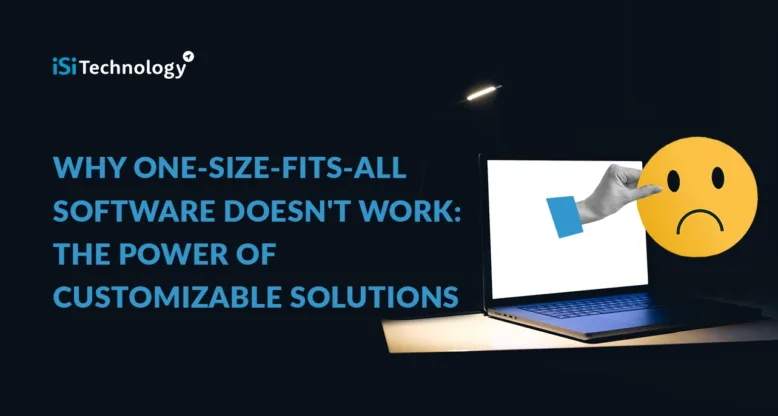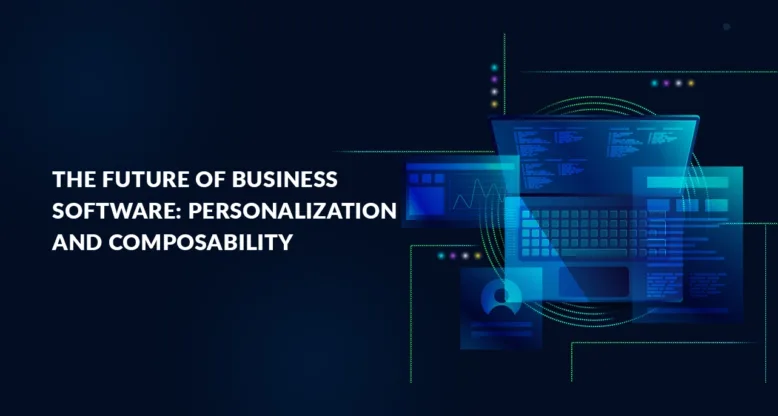Why One-Size-Fits-All Software Doesn’t Work: The Power of Customizable Solutions

Every business person’s day is filled with tough choices and important decisions. Eliminating at least one of many dilemmas would be a great relief. That is why when the time comes to choosing a software platform for major operations, companies tend to gravitate towards “magical” solutions that promise to solve all their problems with minimal effort. The appeal is obvious: lower costs, ease of implementation, and a peace of mind knowing that many businesses seem to be satisfied with this solution.
However, let’s explore the other side of one-size-fits-all fixes. Once the magic dust settles, many software users face disappointment, inefficiencies, and have to concede missed opportunities that are associated with trying to solve all of the problems with a single “digital hammer”. Every business is unique. As a business owner, you want to maximize success and in this case dedicated software becomes not a luxury but an essential tool. In this article we will discuss the major benefits of equipping your enterprise with flexible and customizable software instead of sticking with rigid universal solutions.
The Fundamental Flaws and Hidden Costs of One-Size-Fits-All Software
The Myth of Universal Business Needs
Despite what software vendors might claim, no two businesses are alike. Even companies in the same industry have unique workflows, company cultures, and operational requirements. Consider a gourmet restaurant versus a fast food chain, a small pediatric practice versus a general hospital, or a local credit union versus a nationwide bank. These institutions indeed operate in related sectors, but will have quite different requirements for optimal operation and regulatory compliance.
The Feature Bloat Problem
A software vendor that attempts to satisfy a wide range of customers, will end up packing their software with countless features that most users will not ever use. This universal yet redundant functionality costs extra but ultimately results in “feature bloat.”. The cluttered and confusing interfaces of “Swiss Army knife” software overwhelm users and slows down the system. The Feature bloat is not only a financial overkill, but a handicap to productivity and efficiency.
The Lowest Common Denominator Effect
When software is designed to satisfy everyone, it often ends up satisfying no one. This is called the “lowest common denominator” effect, where features are diluted to work for the broadest possible audience, but ultimately lack the depth and specialization to satisfy any business. Imagine an accounting tool that technically can handle enterprises of all sizes, but actually doesn’t excel in any particular area and lacks creativity to solve unique business problems. In this case, the users are left constantly working around limitations rather than being empowered by their tools.
Integration Nightmares
Modern businesses use a web of services and interconnected systems for accounting, customer management, inventory, communication, and more. One-size-fits-all software will likely fail to integrate smoothly with existing systems leading to expensive middleware solutions, custom connectors, and sometimes complete system overhauls. Poor integration can lead to data silos, necessity of manual data entry and fragmentation, which jeopardize digitization and streamlining of operations.
Workflow Disruption Costs
The workflow disruption is the most significant hidden cost of one-size-fits-all software. Instead of your team slowing down, being forced to change their proven processes to match the new rigid digital structure, the software must adapt and provide an immediate efficiency boost.
Training costs and time wasted skyrocket when the software doesn’t align with natural business processes. Moreover, employees productivity and job satisfaction plummets if you’re essentially retraining them to do their jobs in an entirely different way for the sake of software compatibility.
Scalability Limitations
As your business grows and evolves, your software needs to change too. Unfortunately, one-size-fits-all software systems don’t scale gracefully with your business. What worked for a 10-person startup is definitely inadequate for a 100-person company, but the bigger a company gets, the more complicated the switch to a new platform becomes. Businesses should avoid the trap of generic software that seems like a safe and cost-effective option in the moment. Just a couple of business cycles in the future, they can discover the need to migrate to something better—at much higher cost and complexity than if they had chosen the right customizable solution from the beginning.
The Power of Customizable Software Solutions
Customizable software takes the opposite approach: instead of forcing its constraints upon your business, it adapts to your operational framework, company values and needs. This means agile workflows that match your team’s natural processes. You get custom fields and modules that provide specific functionality and capture data tailored to your KPIs.
Personalized Workflows Your team is the only entity that knows how to effectively run daily processes. Therefore, the software’s main task is to enhance what your team does well rather than forcing new ways upon them. A law firm should be able to customize case management software with jurisdiction-specific deadline tracking and legal research database integration, while a marketing agency should use a platform with campaign performance tracking and client approval workflows. Employee empowerment through digital means that embrace the company’s procedures results in shorter learning curves, higher adoption rates, and immediate productivity improvements.
Modular Architecture works like building with LEGO blocks. You can start with foundation pieces every business needs and gradually request specialized modules once specific requirements become clear. This pay-as-you-grow model, where you only pay for the software modules you actually use, can make scaling much more affordable.
Competitive Advantage emerges when flexible software becomes customized to your specific business model. According to the ERP Software Market Report 67% of those companies that chose to use quite rigid ERP (Enterprise Resource Planning) systems, eventually requested customization to tailor them to specific needs and only then experienced a true boost in business processes.
Industries Where Customization is Critical
Software customization is universally recognized as more beneficial, but certain industries demonstrate more prominently that one-size-fits-all solutions fundamentally fail to meet specialized business needs.
Healthcare showcases the most obvious need for customization. A pediatric clinic functions entirely differently from a surgical facility or psychiatric practice. Primary care physicians need comprehensive patient histories and detailed longitudinal records, whereas emergency departments require immediate access to vital, life-threatening information. Medical equipment integration presents another layer of complexity. Connecting simple monitoring devices to EHR systems demands vastly different technical approaches than integrating sophisticated diagnostic imaging equipment.
Another prominent example is the business requirements within the NEMT industry. A single van NEMT provider will need different software functionality than a nationwide non-emergency medical transportation fleet. For instance, RouteGenie scheduling, routing and billing NEMT software has a highly customizable design that allows adjusting the system to match the provider’s requirements. It is flexible enough to adapt to unique compliance requirements and patient data handling needs of any player within the medical transportation niche.
Manufacturing presents an equally diverse landscape of requirements. Let’s take pharmaceutical manufacturers who operate under entirely different FDA regulations than furniture makers or electronics plants. Custom inventory functionality might be crucial all of them, but some will need a lot of tracking for quality control, while others require just-in-time management or complex supply chain coordination. Each industry will have unique integration with specialized machinery, sensors, and automation systems, which demands tailored solutions.
The financial service industry as a whole faces different distinctive issues when it comes to regulatory compliance, risk management, and reporting requirements. From community banks to investment advisors, and even cryptocurrency exchanges, all require specific tools due to working under different rules which makes constant adaptation in reporting systems mandatory.
Professional Services categorically ranges from law offices to creative agencies. These firms face completely different project management needs along with generic software being ineffective when it comes to client deliverables resulting in generic non-differentiated billing structures.
The Future of Business Software: Personalization and Composability
The shift from a one-size-fits-all model is now focusing on the customization of business software. Forbes informed us on the results of a 2022 survey that up to 73% of companies regard collaboration and customized tools important for project milestones. Businesses are becoming adept at tailoring programs to specific processes because of AI, no-code platforms, and ecosystem-specific technologies.
In addition, another trend worthy of noting is the increase in modular systems that rely on API-first technologies called composable applications. These provide businesses with an advantage over their competitors through enhanced agility as well as precision since these systems seamlessly integrate the reliability of established platforms along with the adaptability of custom-built solutions.
Conclusion
Now more than ever, agility, efficiency, and differentiation are critical for a business to succeed. It is no longer effective to settle for off-the-shelf software solutions. While generic platforms may provide immediate cost benefits, they tend to compromise “performance, adaptability,” and stunted growth in the long run. Customized software can be tailored to the specific requirements of a business’s technology ecosystem, workflows, and objectives providing enhanced productivity and operational efficiency; such systems also ensure helpful strategic edge over competitors. Businesses that invest in sophisticated responsive modular systems that can be developed by iSi Technology will lead their industries as such systems evolve.


